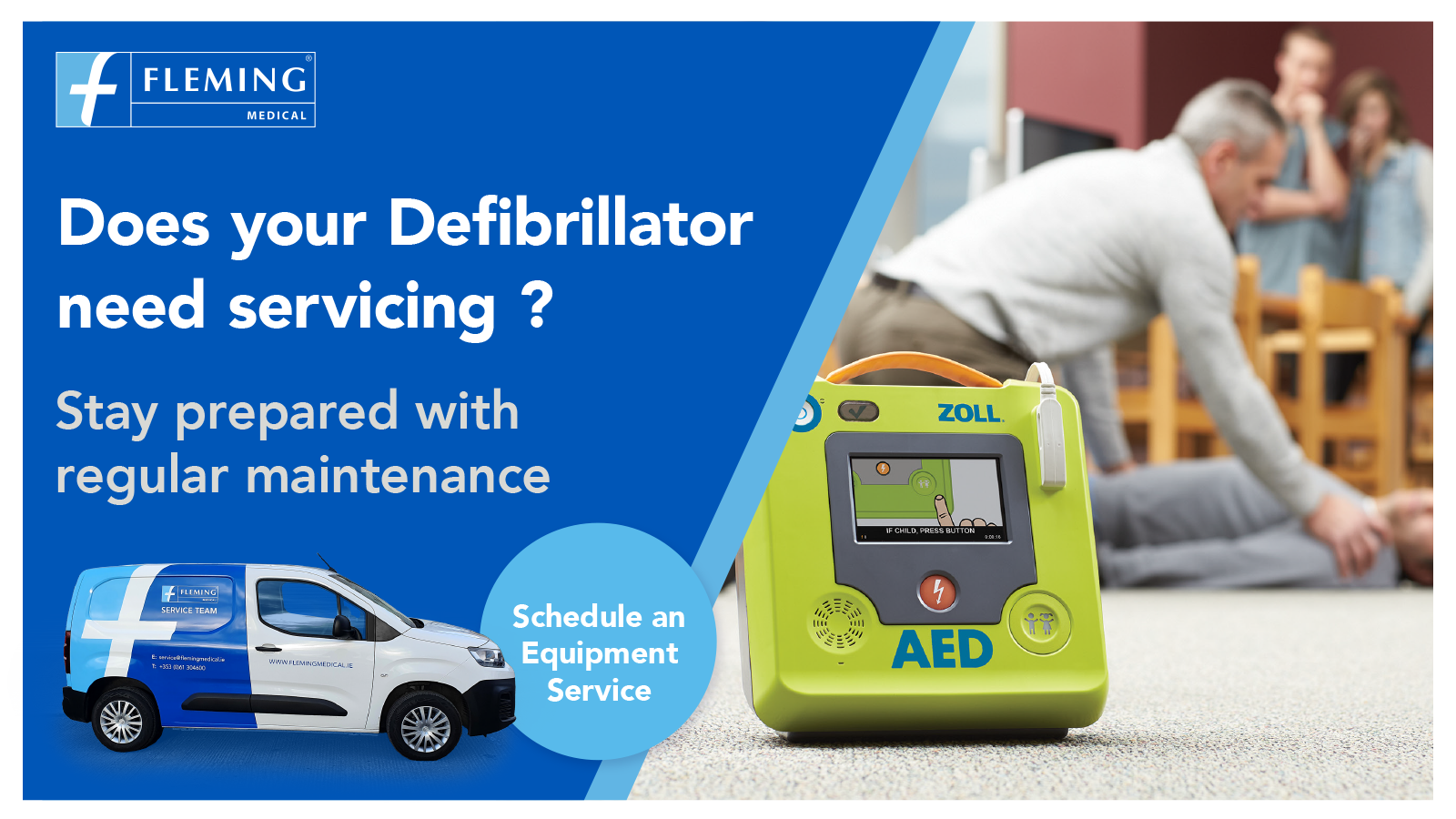Headlines
- Keeping Customers Covered: How Pharmacies can address the Summer Burn Surge - A clinical and practical guide for pharmacy teams
- Fleming Medical Achieves ISO 13485 Certification – Reinforcing Our Commitment to Patient Safety and Quality
- Gentle Daily Ear Care with Medicare Ear Spray
- Breathe Easy with Medicare Nasal Spray
- Fleming Medical Renews Support for Irish Heart Foundation’s “Before Damage is Done” Campaign with over €25K Donation
The Essential Guide to Recognising When Your Defibrillator Needs Servicing
02 April 2025
A quick service check today could mean the difference between life and death tomorrow.

Every minute without defibrillation decreases a cardiac arrest victim’s survival rate by 7-10%. Is your AED ready when it’s needed most?
A well-maintained Automated External Defibrillator (AED) is crucial for an effective response in sudden cardiac arrest situations. Knowing when your AED requires servicing is key to ensuring its reliability. This guide highlights the critical indicators and essential facts about defibrillator maintenance.
Recognising the Signs: When Does Your AED Need Servicing?
- Error Alerts: Modern AEDs perform self-tests and will indicate maintenance needs through visual or auditory alerts. These may include messages or beeps signalling issues such as a low battery, expired pads, or internal malfunctions.
- Expired Components: Check the expiration dates on your AED’s electrode pads and batteries. If any of these components are near or past their expiry date, it is time to schedule a service. Typically, batteries and pads should be replaced every 2 to 4 years.
- Post-Use: After any use of an AED, it is essential to have it serviced to ensure all components are functioning correctly and ready for the next emergency.
The Importance of Regular Servicing
- User Responsibility: AED maintenance is typically the responsibility of workplace health & safety officers, facility managers, or designated staff in public and private organisations. Regular servicing ensures compliance with safety standards and reduces the risk of failure during an emergency.
- Service Frequency: To prevent failures during emergencies, it is recommended that defibrillators be serviced annually. This helps ensure that all parts are working correctly, that software is up to date, and that consumables like pads and batteries remain within their effective period.
- Common Issues: Routine servicing helps prevent common AED malfunctions, such as battery drainage, electrode pad adhesion failure, software glitches, and faulty charging mechanisms. Addressing these issues proactively ensures the device is always in optimal working condition.
- Emergency Readiness: In addition to scheduled servicing, regular visual checks should be conducted to confirm that the AED is fully operational. Ensure the battery indicator is functional, pads are in date, and the device is stored in an accessible location.
Fleming Medical’s Commitment to Excellence
At Fleming Medical, we understand the pivotal role that AEDs play in saving lives. We provide comprehensive AED servicing that includes:
- Thorough Inspections: Our technicians conduct detailed visual and functional inspections to identify any potential issues.
- Replacement of Expired Components: We replace any expired pads and batteries, ensuring your device remains in optimal condition.
- Up-to-Date Functionality: We perform software updates and functionality tests to meet the latest standards.
Conclusion: Stay Prepared with Regular Maintenance
Ensuring your AED is serviced regularly is not just about compliance—it is about readiness to save lives. With Fleming Medical, you receive reliable service that prepares your AED for when it matters most. Do not let an emergency reveal the need for maintenance. Be proactive and keep your device in life-saving condition.
Don’t wait until an emergency exposes a problem—schedule your AED servicing today with Fleming Medical to ensure it’s ready when it matters most - visit Fleming Medical’s service page.
Remember, a maintained AED is a reliable lifesaver.

 Fleming Medical UK
Fleming Medical UK
